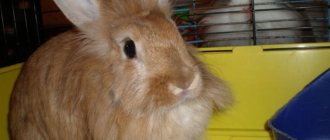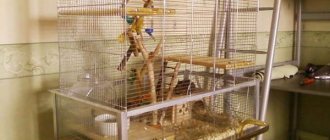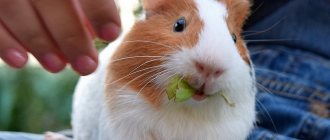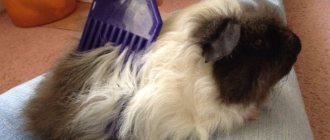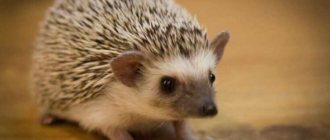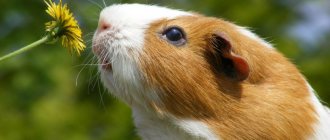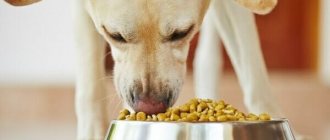Home » Dog Breeds
When a Labrador puppy first appears in a family, few owners think that the dog will go with them through life for ten or fifteen long years.
The first six months, during which the dog’s character and habits will be formed, neatness skills and the basics of obedience will be created - this is the most important period in the dog’s life.
Love for the owner is an important quality, but it appears gradually, in the process of playing together, everyday care of the pet and walks.
Consequently, raising a dog begins from the first moment after it appears in the house.
This Labrador puppy is a big fan of taking pictures.
- 2 Accustoming to neatness
- 3 Vaccinations for Labrador puppies
- 4 Raising a Labrador puppy
- 5 Physical activity
- 6 Contact with the owner
Description of the breed
Today, the Labrador dog is one of the most popular breeds around the world, and the number of its admirers is constantly growing. The pet is considered an impeccable family dog, combining the best qualities: sociability, devotion to the owner, calmness, friendliness. It is generally believed that Labradors were first bred on the Canadian islands. However, there is still much controversy surrounding the origin of the breed.
Some believe that at first Labradors were exclusively black, and were named after labradorite, a mysterious dark stone. The opposite opinion says that the breed originated on the Labrador Peninsula of the same name.
Due to their sharp mind, intelligence and balance, Labradors are often used as service dogs. The training of these dogs is not based on anger and grueling exercises, but solely on loyalty to people.
There have been cases when pets came to the aid of epileptics, since animals have the ability to anticipate seizures. In case of danger, the dogs try to warn the owner about the threat and give a sign for him to find a protected corner for himself.
What a Labrador looks like is known to both experienced and novice dog breeders. This is a large, muscular dog with a solid build. He has a flat skull, a deep chest and a strong back. The main characteristics of the breed include a clear transition from the forehead to the muzzle, medium-sized eyes and drooping ears. Labradors come in 3 colors: black, fawn and brown.
Labrador is a dream dog, attracting with its boundlessly devoted eyes
The feeding pattern for all puppies is the same: a 3-month-old Labrador should be fed 6 times a day, a puppy under 5 months should be fed 5 times, and 7-month-old Labradors should be fed a maximum of 4 times a day. After 9-10 months, dogs switch to 3 feedings a day, and after a year, the Labrador is fed 2 times at a clearly established time.
How much does an adult dog weigh?
Labrador is a large breed of dog. The sizes depend on the sex of the individual; girls look slightly smaller than boys. Optimal performance for an adult dog:
- height – 0.56-0.63 m (for a male) and 0.54-0.6 (for a female);
- weight – 27-40 kg (for a male) and 27-35 kg (for a female).
During canine shows, experts take measurements of dogs and compare them with standard indicators. The breed has 3 recognized standards: international, English and American. British and world standards are almost identical. They allow deviations from growth parameters of up to 1 cm. The American template is more flexible. According to it, the height of the animal at the withers may differ by 3-5 cm.
Body weight is not so strictly regulated. However, the general proportions (the ratio of height at the withers and weight) must be maintained. As a rule, an adult Labrador weighs around 30 kg. Excess weight affects your pet's health. Owners must properly balance the daily diet of the ward, and also pay attention to physical activity during walks.
How much does your Labrador weigh?
Gallery: Labrador puppies (25 photos)
First vaccinations
At the age of 1 month, the puppy needs to be dewormed.
The first comprehensive vaccine for dogs against distemper, infectious hepatitis, parvovirus enteritis, parainfluenza and leptospirosis is given 10 days after deworming. After 14 days, a second comprehensive vaccination is given, at this stage vaccination against rabies is also carried out. Quarantine lasts 10-14 days after the second vaccination, revaccination - once a year.
Puppies are vaccinated according to the schedule from the vaccine manufacturer. Veterinary clinics offer vaccines from domestic and imported manufacturers, for example, Biovac, Multikan, Nobivak, Vanguard, Duramun, Eurikan.
Choosing a puppy
Selecting a purebred puppy is a difficult step that requires maximum responsibility. First of all, you need to determine the purpose for which you want to purchase a pet: do you dream of prizes and awards, or simply need mutual love.
Of course, dogs for participation in exhibitions cost more than ordinary pets. It is also necessary to understand that the guarantor of triumph in bets is neither the cost of the dog nor the owner’s offer, however, responsibility for the pet lies entirely with you, regardless of whether the dog wins prizes or not.
The best period when puppies can already be separated from their mother is considered to be 4-8 weeks. When choosing a Labrador, you need to pay attention to where it is kept. If the dog is in good conditions and surrounded by space and comfort, this indicates the care and love of the owner for his pet.
How to train a dog
When training a dog, the key is to be patient. No need to be aggressive. Labradors are very smart dogs and quickly grasp everything on the fly, but it takes time for them to start following certain commands. It is best to alternate activities so that your Labrador does not get bored with the activity and become distracted by something else.
It is very important to socialize a Labrador so that the dog does not show anxiety around other people or animals, behaves with dignity during walks, and does not experience stress.
Features of care
The dog has absorbed many talents and abilities. She is not only a reliable guard for her owner, but also a loyal friend and a hardworking assistant. Those who decide to purchase a Labrador must take into account that caring for and raising an animal requires considerable effort. This rather temperamental dog needs long walks, training and outings. If the owner fails to provide the dog with such conditions, it will find entertainment for itself, which, most likely, the owner will not like.
Caring for a Labrador's coat is a simple process; you just need to brush the dog once a week with a special rubber brush. If your pet is accustomed to this procedure in time, he will even be able to love it. Brushing is beneficial for a dog as it increases blood circulation, removes fallen hair and stimulates the growth of new hair. Among other things, it is advisable to periodically examine the dog’s ears, eyes, teeth and claws for infections or other diseases, and if signs of any illness are detected, you should immediately seek help from a veterinarian.
Pet health
Animals are quite fragile, so you need to contact a veterinarian with the slightest problem. Only a qualified veterinarian will help the dog. Representatives of this breed are prone to acute respiratory viral infections, allergies, and obesity. Dogs are regularly vaccinated according to the vaccination calendar.
The troubles of caring for a four-legged friend are more than compensated by having a faithful, kind and affectionate companion nearby. Moreover, the flexible nature of the Labrador allows him to get along well with the older generation and children.
Labrador training
The Labrador is a sincere dog whose character depends entirely on its emotional connection with its owner and other people close to it. The more time and love he gets from his owner, the more trusting and devoted a pet is.
The introduction of a Labrador puppy into the home should be carefully thought out. First of all, you need to remove all dangerous objects from general availability, arm yourself with healthy nutritious food and toys. The pet must also be given a personal place to rest.
Commands such as “Down!” and “Near!”, you should start training your Labrador puppy at 1 month. The dog gets used to his name quickly enough and within a few days begins to understand that his name is his. You should not yell at a dog if it does not come on command, even if there are good reasons for this.
Labrador puppies should be accustomed to intensive training at 3 months. During this period, they are already more intelligent and resourceful. However, each dog shows individual capabilities and training abilities. Some Labradors master the necessary commands in two to four weeks, while others achieve the same results within several months. It is important not to overload the dog and give him time to rest from constant training.
About natural food
If you decide to feed your dog food of natural origin, then you should learn a few simple rules:
- Dogs of this breed are highly prone to allergic reactions, so introduce all new foods into the animal’s diet gradually and in small quantities.
- Many Labrador puppies cannot tolerate buckwheat. But all protein products - meat, fish, cottage cheese, kefir, as a rule, are absorbed well. They gradually become familiar food for the family pet. Instead of buckwheat, the animal is fed wheat, corn, and barley groats.
- Vegetables and fruits are well tolerated by animals, especially since they are a source of complete vitamins and microelements. The animal can be given boiled cabbage, peppers, tomatoes. As for fruits, many Labradors eat apples, pears, persimmons, and watermelons well. But remember the risk of allergies; the first time you feed a new product, make do with a small piece.
- After 3 months of age, the baby can be given soft cartilage and beef bones.
Beef bones for dogs
History origin
The Labrador is a large enough dog to live carefree in an apartment. There will always not be enough space for either her or you. But at the same time, this dog has plenty of advantages. That's why many people dream of having a pet Labrador.
Dreams simply must become reality, even if it is difficult to believe that what is happening is not a fantasy. Yes, indeed, today everything is possible and a new species that exactly replicates a copy of a popular large animal, only smaller in size, also actually exists.
How could this happen? As with other difficult questions, there will be several answers:
- a man intervened. Dog handlers were interested in developing a new breed that would be more satisfying in size than the original. Labrador is one of the most popular breeds and the demand for it would be even greater. How many apartment dwellers dream of this four-legged friend, but are afraid of the large size of the animal and the small square footage of their own home. The parents of the mini Labrador were a female of the usual standard and a male dwarf Labrador. As a result, the father's genetics turned out to be stronger, and humanity received something average in size and identical in all other respects to a domestic animal,
- inbreeding. If you cross two close relatives, the genetics may fail. This is what happened with puppies that received two completely identical defective genes. As a result, growth slowed down and stopped at a level below fifteen centimeters of the height of a standard adult individual. In addition to short stature, the animal may suffer from other genetic diseases.
Despite such questionable origins, the new variety of mini-Labradors immediately fell in love with many . Contrary to fears of genetic diseases, mini Labradors look quite healthy and happy with life. They have the same energy and need for active games as the standard representatives.
Advantages and disadvantages
If we assume that a smaller copy of a Labrador retriever has retained all the qualities of larger representatives of this species, then the advantages of such dogs are:
- compact size and easy to maintain even in apartment conditions;
- playfulness, good nature and lack of aggression;
- using dogs as guides, companions and nannies;
- good service and security qualities.
The disadvantages may be:
- constant shedding;
- requirement for long walks;
- excessive hyperactivity;
- intolerance of being alone;
A big plus in the character of a dwarf Labrador is friendliness and lack of aggression.
Proper feeding
Both large and small Labradors are very voracious.
It doesn’t matter are fed industrial feed or natural products, the main thing is to avoid overeating and follow a few simple rules :
- Do not mix dry food and natural products. This can lead to indigestion and the occurrence of gastritis, ulcers, and cancer.
- Portions should be appropriate for age, weight and level of physical activity. Normally, a dog with optimal weight should have easily palpable ribs.
- When feeding industrial feeds, preference should be given to brands with a protein content of at least 60%. This is especially true for puppies during the period of active growth.
- The menu should not include pork, raw river fish, milk, legumes, baked goods, fresh bread, smoked meats, pickles, products containing spices, seasonings, flavorings, legumes, potatoes.
- A menu consisting of natural food should be enriched with a vitamin complex, a recipe for which can be prepared after consulting with a veterinarian.
NOTE!
The share of meat or offal in a properly formulated diet should be at least 50%, and vegetables, herbs, and seasonal fruits - 25%. The remaining 25% of the portion includes cereals, low-fat fermented milk products, boiled eggs (no more than two per week).

